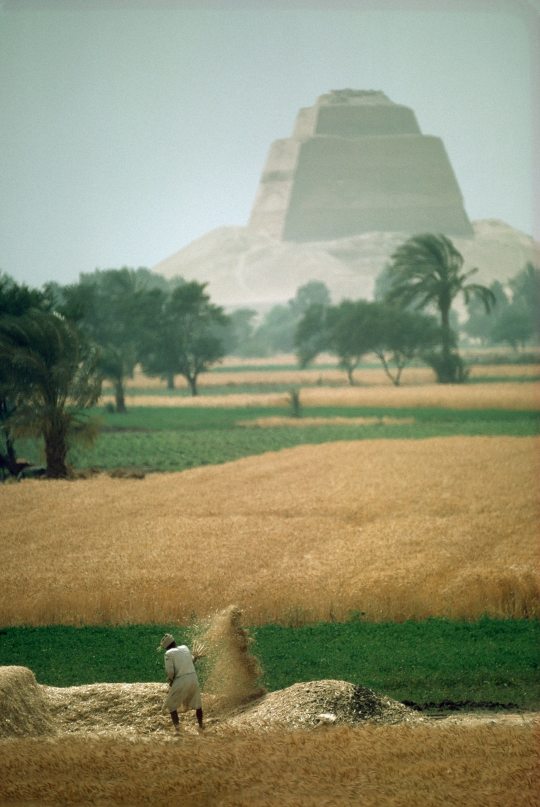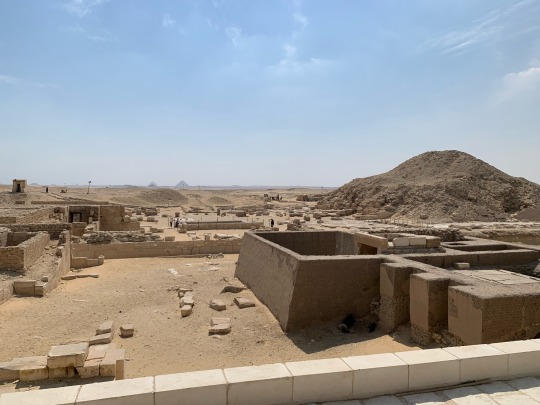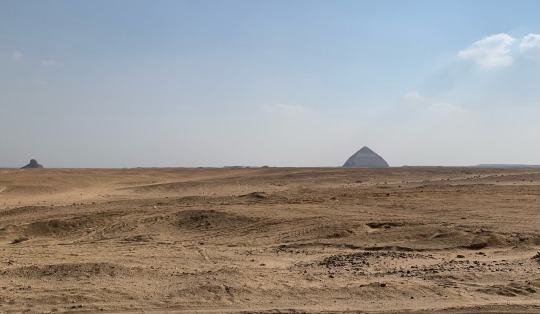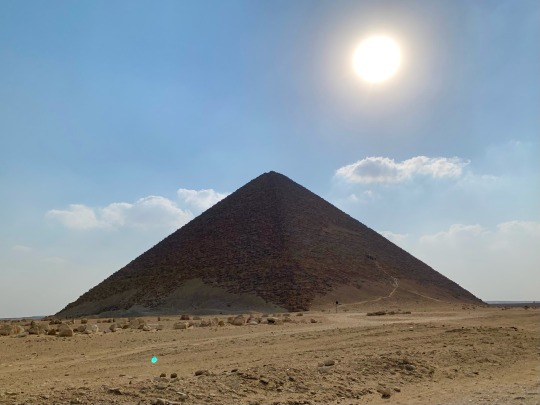#Snofru
Explore tagged Tumblr posts
Text

THE SIGHTS OF FERTILE, ANCIENT, & ABUNDANT LOWER EGYPT.
PIC INFO: Resolution at 2055x3072 -- Spotlight on the Pyramid of Snofru, Meidum, a.k.a., Pyramid of Meidum near El Faiyum, Egypt (62 miles southwest of Cairo), from the pages of "National Geographic" magazine, c. March, 1977.
Source: www.nationalgeographic.com/culture/article/neolithic-agricultural-revolution.
#Pyramid of Snofru#Pyramid of Meidum#Lower Egypt#Ancient Egypt#Egypt#North Africa#North African#Africa#African#National Geographic#1970s#Snofru#Meidum#Ancient Egyptian#Pyramid#Pyramids#Agriculture#MENA#Middle Eastern North Africa#Middle East North Africa#Landscapes#Photography#Super Seventies#70s#1977#National Geographic Magazine#National Geographic magazine
2 notes
·
View notes
Text

Looking south from the step pyramid, King Djoser's legacy - the pyramids of his great grandson, Snofru (and, in the foreground, the much later pyramid of King Unas, now in bits).
#pharaoh#travelswithasword#pharaohs#unas#djoser#snofru#egypt#egyptology#egypt travel#cairo egypt#ancient egypt#egyptian#egypt holidays#saqqara#meidum#dahshur#pyramid#pyramids#pyramid of unas#bent pyramid#red pyramid#collapsed pyramid#step pyramid
3 notes
·
View notes
Text

Statue of Snofru-nefer, a court official
Snofru-nefer was the principal singer and the overseer of amusements at the royal court. His statue is a prime example for demonstrating the fundamental principles of the Egyptian sculptor. The upright posture and the positioning of the arms at a straight angle with the shoulders demonstrate the strict adherence to straight angles. The statue is symmetrical except for the advanced left leg.
The meaning behind this depiction is not entirely clear. It is probably connected with the concept of rejuvenation after death. The craftsmanship and artistic value of this piece are extraordinary. Even the smallest details have been depicted. The youthfulness of the subject is expressed by the still somewhat weak outlines of the face and the masterfully crafted youthful body.
Old Kingdom, late 5th Dynasty, ca. 2400 BC. Painted limestone. From Mastaba of Snofru-nefer, Giza. Now in the Kunsthistorisches Museum, Vienna. INV 7506 Read more
22 notes
·
View notes
Text
Is It Normal to Have a Favorite Pyramid?
Because I do. And it might be a slightly weird choice.

Photograph of the Meidum Pyramid, courtesy of Wikipedia
The Bent Pyramid is one of three pyramids attributed to the Old Kingdom Pharaoh Sneferu (also spelled Snefru, Snofru, and Hellenized as Soris). These three pyramids, if looked at in order of construction, showcase the evolution from step-pyramid to true pyramid in Egypt. The first pyramid attributed to Sneferu, the Meidum Pyramid (pictured above), was originally constructed as a step-pyramid, but was later encased and transformed into a true pyramid following the completion of the Bent Pyramid and the Red Pyramid.

Photograph of the Bent Pyramid, courtesy of Wikipedia
What makes the Bent Pyramid so special is its iconic shape. About halfway up the pyramid, the angle of incline changes from 54 degrees to 43 degrees. This change is likely due to a certain level of instability that was caused by the steep initial incline, forcing builders to change to a more gradual slope. This instability is also likely why the Red Pyramid, the last one built by Sneferu, was constructed entirely at a 43 degree incline.

Photograph of the Red Pyramid, courtesy of World History Encyclopedia
The reason that the Bent Pyramid is my favorite pyramid in all of Egypt is that it is so distinctly human. When looking at ancient artifacts and monuments, we tend to deify the creators. The Bent Pyramid shows us that even these ancient architects and mathematicians, the people we study and fawn over as geniuses, could and did make mistakes.
4 notes
·
View notes
Text
What was one of the most incredible scientific experiments in history?
During summer of 1945, two physical chemists, Willard Libby and James Arnold, were performing experiments on two samples taken from the tombs of two Egyptian kings, Baby Yoda Boomer Star Wars Ugly Christmas Sweaterand Snofru dated to 2625 BC. They had the assumption that whenever a living body dies, it stops exchanging carbon with its environment and the amount of Yoda Xmas Sweaterit contains, begins to decrease as it goes radioactive decay. So by measuring the proportion of carbon in a sample from a living body one can calculate the approximate date, when the body died.(1)
Professor Willard Libby, at the University of Vader Lack Of Cheer Star Wars Ugly Sweater. He got Nobel Prize in Chemistry in 1960.
Their results were published in a paper Science in December 1949, in which the experimenters commented that their results implied it would be possible to determine the accurate age of materials containing carbon, and they named this method, a radiocarbon-dating. Soon after this publication, universities around the This Is The Way Baby Yoda Star Wars Ugly Christmas Sweater began establishing radiocarbon-dating laboratories and by the end of the 1950s this method brought a carbon revolution in the field of archaeology 'cause it provides more accurate scale of dating the prehistoric time with regional and continental boundaries. This experimental technique is absolutely incredible.



0 notes
Photo

The Evolution of Snefru’s Pyramids 𓍋𓅓𓂋𓉴𓏫 “mrw”.𓏤 1. The first attempt at a pyramid at Meidum/Meydum, failed due to unsecured casings.𓏤 2. The Bent pyramid at Dashur, failed due to cracking interior walls and supported by cedar wood beams inside the pyramid, but completed with a lesser angle.𓏤 3. The Red Pyramid, the first ever completed true pyramid at Dashur.𓏤 Sneferu (𓋴𓄤𓆑𓂋𓅱) “snfr-wj” ‘He has perfected me’, also read Snefru or Snofru, well known under his Hellenized name Soris (Koinē Greek: Σῶρις by Manetho).𓏤 He was the founding pharaoh 𓉐𓉼 “pr-eA” ‘Great House’ of the Fourth Dynasty of Egypt - Beloved Land 𓇾𓌸𓂋𓆵𓇋𓊖𓊖 “tA-meri” during the Old Kingdom. Estimates of his reign 2613 to 2589 BC.𓏤 He built at least three pyramids that survive to this day and introduced major innovations in the design and construction of pyramids, he introduced new style of statue 𓂙𓏏𓏭𓀾 “hnty” building and of turquoise 𓅓𓆑𓂓𓏏𓏬 “mfk.t” jewelry.𓏤 #egypt #egyptian #ancient #ancientegypt #hieroglyphics #ägypten #middleeast #worldtourismday #thisisegypt #egyptologist #myegypt #egyptianhistory #egyptology #archeology #hieroglyphs #madeinegypt #egypte #egyptians #egyptshots #loveegypt #discoveregypt #ruins #snefru #pyramid #bentpyramid #meidum #dashur #redpyramid #pharaoh https://www.instagram.com/p/CHV81RFr3mb/?igshid=1an7oyh00ttfs
#egypt#egyptian#ancient#ancientegypt#hieroglyphics#ägypten#middleeast#worldtourismday#thisisegypt#egyptologist#myegypt#egyptianhistory#egyptology#archeology#hieroglyphs#madeinegypt#egypte#egyptians#egyptshots#loveegypt#discoveregypt#ruins#snefru#pyramid#bentpyramid#meidum#dashur#redpyramid#pharaoh
6 notes
·
View notes
Text

Las Ocas de Meidum es un friso datado aproximadamente entre los años 2.613 a.C. y 2.498 a.C., perteneciente al arte egipcio, en concreto fue realizado durante la IV dinastía del Antiguo .
Fragmento mural de la mastaba de NefermaatLa "mastaba número 16 " es la mastaba de Nefermaat y su esposa Atet.
Nefermaat era hijo y Visir del faraón Snofru (fue el primer faraón de la IV dinastía, perteneciente al Imperio Antiguo, también conocido como Seneferu, Esnefru, Snefru o Sneferut).
#iregipto #egyptpassion #discoveregypt #meidum
24 notes
·
View notes
Photo

Climbing 65 m into the Red Pyramid to the tomb of Pharao Snofru. #austrian #austrianairlines #kairo #cairo #nil #nile #ägypten #egypt #sofitel #egyptair #assuan #aswan #oldcataracthotel #redpyramid #snofru (hier: Red Pyramid)
#aswan#oldcataracthotel#nile#egypt#ägypten#nil#cairo#austrianairlines#austrian#assuan#kairo#sofitel#redpyramid#snofru#egyptair
0 notes
Text
Snofru is the original inspirational poster because our dude got knocked down but came back up again each time and eventually he came out victorious and built himself a lasting pyramid
5 notes
·
View notes
Text



The Collapsed, Bent and Red Pyramids of Dahshur. Guest appearance by Ra.
Following the creation of Djoser's step pyramid, the Ancient Egyptians began to experiment with the true pyramid form. Snofru appears to have built no less than three pyramids. What happened to the Collapsed Pyramid is somewhat self explanatory. When it came to the Bent Pyramid, someone seem to have realised that if they continued to build at such a steep angle, they would soon have a Collapsed Pyramid Mark 2, so the angle was changed partway through to be less steep, leading to its characteristic 'bent profile. Finally, Snofru's labour force completed the Red Pyramid, the first true pyramid built in Egypt. It's not as large as the Great Pyramid on Giza, but it's y'know pretty big and impressive anyway. And as you can see by the landscape, delightfully empty of tourists! (Because somehow, most tourists groups forget that the Dahshur and Meidum cemetery complexes exist).
#Dahshur#meidum#Egypt#ancient egypt#egyptology#Kemet#Kemetic#Kemeticism#pyramid#pyramids#red pyramid#bent pyramid#collapsed pyramid#desert
45 notes
·
View notes
Text
Templos Solares
Se construyeron en la dinastía V, en este período tuvo un fuerte auge la religión solar a Ra.
Tenían una estructura rectangular delimitado por un muro, el templo superior o mayor estaba a cielo abierto, donde estaba el altar y una pirámide truncada con un obelisco sobre él.
Conectado por una rampa a un templo menor, además fuera del recinto hay otros edificios para culto y almacenamiento.
Tenían una función de culto al dios solar pero también de pirámides para los gobernantes, ya que en este periodo, las pirámides como tumbas habían reducido sus tamaños y esplendor, a diferencia de lo que se puede ver en la dinastía IV con las pirámides de Guiza o las tres pirámides del rey Snofru.
Uno de los templo solares mejor conservado es el de Abu Gurob, mandado a realizar por el rey Neuserre y el gran templo de Heliopolis no ha llegado hasta nuestros días.


0 notes
Text
He is still a King was huge very huge. These here disrespect all are very rambunctious and juvenile mostly bja the last one talking as a black person there tonight and it is happening right now. He will die now.. Soon. They all will but our boy. Need it all now. We learned it from the hangings
Thor
0 notes
Link
King Sneferu Egypt – Secrets Life Famous Celebrities of Ancient Egyptian Pharaohs. History, Facts and Biography Snofru, Snefrue 1st King of Egypt’s 4th, Accomplishments, wife, children, meidum red bent pyramid and more.
0 notes
Text
Das Alte Ägypten: Die Menschheit wächst über sich hinaus - Teil 4
Die Kontrolle und der Einfluss, den ein König nun in Ägypten wirken lassen kann sind nun an einem Punkt angelangt, den Menschen unglaubliches vollbringen lassen. Ich habe mich den vorherigen Beiträgen mit dem Ende der Nomaden und dem Anfang der Sesshaftigkeit am Nil beschäftigt. Mit dem Aufstieg eines Herrschaftssystems mit strenger Hierarchie. Selbstdarstellung der Macht in Form von Symbolen, strenger religiöser Ehrfurcht und neuen Erfindungen, wie Buchhaltung, um eine Verwaltung zu verfeinern. Import und Export auf vielen Handelswegen, um so Stärke und Stabilität in einem nun einheitlichen Staat zu gewährleisten. Und zu guter Letzt, die Aufteilung in Gaue und den Bau der kleinen Pyramiden, verteilt über die Gaue, für einen geregelten und gesichterten Steuerfluss. Mit dieser steigenden Macht, steigt der Wille diese macht zu zeigen, was die Ägypter sehr gerne mit Gräbern bewerkstelligen. Wie schon in Teil 3 erwähnt, geht es nun um die drei Pyramiden in Gizeh und ihrem Bau. Die größten Pyramiden, mit vergleichsweise primitiven Werkzeugen? Ist das überhaupt möglich?
Das faszinierende ist, dass es tatsächlich möglich ist. Aber wie? Bis zu diesem Zeitpunkt wurden nur kleinere Stufenpyramiden gebaut. Auch Snofru, Vater von Cheops, baute eine in Meidum. Jedoch konnte er sich damit nicht zufrieden geben. Er wollte sich von allen anderen Königen abheben. Also plante er ein sehr ehrgeiziges Projekt: Er wollte eine geometrische Pyramide, welche einem, sich ausspreizenden Sonnenstrahl, ähnelt. Sie sollte, nach den Plänen 152m hoch werden und glatte Kanten, in einem 60° Winkel, besitzen. Es wurde eine ganze Anlage in Dahschur gebaut: Eine Nebenpyramide für die Ka-Seele* des Königs, eine kleine Seitenkapelle, einen Taltempel für Riten des Königs und einen Aufweg.
Der Bau der Hauptpyramide war ein nationales Projekt, ob es den Leuten gefiehl oder nicht, denn dem Hof und dem König ist alles zu geben, was er verlangt. So auch einen großteil des Fleisches. Es konnte nachgewiesen werden, dass das einfache Volk sehr wenig Fleisch zu Essen hatte. Der Anbau von Getreide war zudem Hauptsächlich für Vieh gedacht, dessen Fleisch schließlich an den König ging. Dies war unter anderem auch die Art der Steuerabgaben. Für das Volk wurde Gerste angebaut, um die Grundnahrungsmittel Brot und Bier herstellen zu können. Macht hin oder her, auch wenn der König als Gott gesehen wurde, war er es letztlich nicht. Beim Bau der Pyramide gab es einige Schwierigkeiten: Da die Pyramide aus tausenden, tonnenschweren Blöcken besteht, entseht folglich eine große Last. Das Problem war, dass ein Wüstenboden schlichtweg wegrutscht, wenn solche Kräfte wirken und genau das passierte auch. Die Baumeister versuchten die Pyramide mit weiteren Blöcken von Außen zu stützen, doch trotzdem sackte die Pyramide auf 54° grad Seitenwinkel hinab. Leider kam diese Abhilfe zu spät, denn überall, in Korridoren öffneten sich Risse, welche notgedrungen mit Gips geschlossen wurden. Alles drohte zu zerbrechen, doch die Baumeister wollten nicht aufgeben. Sie änderten den ganzen Plan und verringerten den Neigungswinkel weiter auf 43°. Zudem wurden die Blöcke nun horizontal und nicht mehr nach innen geneigt angelegt, was die Statik verbesserte. Nun war sie stabil, dem König war das als letzte Ruhestätte aber zu verpfuscht. Sie war nun 105m Hoch und besaß einen Knick, weshalb sie Knickpyramide genannt wurde. Aus seinem Frust heraus machte er nun etwas unfassbares möglich: Er mobilisierte eine unglabliche Menge an Arbeitern und ließ sie an seiner alten Stufenpyramide in Meidum arbeiten, um aus ihr eine geometrische Pyramide zu machen. Er ließ die Arbeiten an der Knickpyramide weiter laufen, um die Schmach einer Niderlage nicht in Kauf nehmen zu müssen und er baute eine völlig neue Pyramide aus rotem Kalkstein, die „Rote Pyramide“, auf einem festen Untergrund. Bei der Roten Pyramide wurde sofort ein geringerer Neigungswinkel verwendet und die Blöcke wurden direkt horizontal gelegt. Außerdem verwendeten sie nach oben hin kleiner werdende Blöcke. So perfektionierte er den Pyramidenbau und nicht nur das: Er schaffte es, während diese drei Baustellen liefen, 100000 bis 150000 Kubikmeter Steine pro Jahr zu verbauen und das in nur zehn einhalb Jahren, was für einen Pyramidenbau der wohl größte Leistung jemals entspricht. Nicht einmal sein Sohn Cheops, dem die größte Pyramide gehört, hat so viele Menschen und so viel Gestein pro Jahr mobilisiert. Somit geht Snofru als der größte Pyramidenbauer in die Geschichte ein. Seine Pyramiden wurden auch gerade rechtzeitig fertig, um ihn zu Ruhe zu betten.
Sein Sohn sollte jedoch ein noch größeres Bauwerk zustande bringen. Auf der Hochebene von Gizeh wurde zunächst eine starke Schicht Kalkstein als Untergrund verwendet, um diese riesige Last zu tragen. Der Vorteil der Lage war, dass in der Nähe sehr viel Baumaterial war und im Sommer die Überschwemmungen im Nil den Booten das Anlegen ermöglichte. So konnte Material aus ganz Ägypten geliefert werden.
Die Ausmessung der Pyramide erfolgte über die Ausrichtung der Sterne. Die Ausrichtung musste genau Stimmen, damit die Pyramide die Auferstehung gewährleisten konnte. Bei dieser Prozedur waren zudem noch Priester und selbst der König dabei.
Als der Bau endlich beginnen konnte wurde, um einen effizienten Bau zu vollbringen, einzelne Einheiten von je zwanzig Männern mit einem Vorsteher gebildet. Diese sollten zu unterschiedlichen Zeiten arbeiten und unter den Einheiten selbst herrschte eine Wettkampfstimmung, was sie zum Bau noch mehr anspornte und das ganze Projekt noch ehrgeiziger werden ließ. Zehn solche Trupps wurden zusammen zu einer Division mit zweihundert Männern. Sie wurden Phylen genannt und fünf von ihnen ergaben eine Arbeitskolonne von tausend Mann. Zwei von diesen Kolonnen arbeiteten als Mannschaft zusammen an der Pyramide. Man kann sich das Vorstellen wie Klassen in Schulen, die miteinander bei einem Wettkampf konkurrieren und dessen Schule nochmal mit anderen Schulen im Bundesland konkurrieren und so nochmal die Bundesländer miteinander konkurrieren.
Doch die Arbeiten waren maximal kräftezehrend. Vorallem im Kalksteinbergbau waren die Arbeitsbedingungen extrem. Überall Staub, Fliegen und härtste Knochenarbeit. Nur die Neuzugänge wurden hier eingesetzt und erst nach dieser Tortur konnte man aufsteigen. Doch auch das Schleppen der Steine war keinesfalls ein leichter Job. Sie mussten auf Schlitten zur Pyramide geschleppt werden und dann auf Rampen hinauf zum Punkt, an dem der Stein gehörte. Alle zwei Minuten, ein Block, zwanzig Jahre hindurch.
Es wurden aber noch weitaus mehr Menschen gebraucht, um so etwas zu erschaffen. Es gab Töpfer, Handwerker für die Holzbauten, Schmiede um Meißel zu reparieren, Bäcker und Bierbrauer für Nahrung. So kam man auf über zehntausend Mann, die gleichzeitig an der Pyramide und ihrer Fertigstellung arbeiteten. Aufseher und Ingenieure lebten auf der Baustelle. Bei den Arbeitern war das etwas anderes. Sie arbeiteten ein paar Monate und gingen anschließend zu ihren Familien zurück. Für sie war es zwar Pflicht aber auch eine Ehre an diesem Projekt teilnehmen zu dürfen, um dem König, ihrem Gott zu dienen. Alles in allem kann man sich das wie eine Stadt vorstellen, in dessen Zentrum ein riesiges Bauwerk entsehen soll.
Trotzalledem war es zum Schluss nur Zwangsarbeit: Es wurden viele Skelette mit verschlissenen Knochen und Wirbelsäulen gefunden. Auch viele mit extremen Knochenbrüchen. Es müssen Todesfälle an der Tagesordnung gestanden haben.
Folglich ist dieses Projekt ist das größte Zeugnis von Macht, da ein König sein Volk dazu in Bewegung setzen konnte, sich an solch einem Projekt mit Stolz und Ehrfurcht zu beteiligen. Und das obwohl jeder wusste, dass es jeden Tag auch ihn erwischen kann. Das es jeden Tag passieren kann, dass sich ein Block löst und ihn zu menschlichem Mus verarbeiten kann. Darauf hat nun die gesamte Machtgewalt des Gottkönigtums, auf die ich ständig zurückkam, hingezielt. Darauf, dass Menschen sich dermaßen aufopfern und das auch noch in so großen Zahlen. Hier wurde es an ein Maximum getrieben. Undenkbar, wenn man an jede andere Monarchie denkt.
Auch sein Sohn Chefren, der jüngere Bruder von Radjedef, der den Sonnengott Re wieder zu enormer größe brachte, baute seine Pyramide in Gizeh. Direkt neben die von Cheops, jedoch auf einer leichten Erhöhung ist die nur 144m hohe Pyramide zwar kleiner aber erscheint trotzdem größer. Er wusste, dass er nie an die Pyramide seines Vater herankommen würde. Er schaffte es trotzdem sich wohl am imposantesten überhaupt darzustellen. Der Auftieg zur Hochebene wurde mit poliertem rotem Granit verkleidet, um einen Bezug zum Sonnengott Re zu schaffen. In der inneren Halle war weißer strahlender Kalzit verbaut und es standen in ihr dreiundzwanzig lebensgroße Statuen von Chefren, welche aus einem schwarz-weiß-gestreiftem Stein hergestellt wurden. Unglaublich eindrucksvoll, vermutlich wie nie zuvor. Doch auch das reichte ihm nicht. So ließ er eine riesige Statue bauen, welche ihn in Verbindung zum Sonnengott darstellte. Die Sphinx. Ebenso riesig wie die Bauten war die Verschwendung an Ressourcen und so wurde auch die dritte Pyramide in Gizeh, von Nachfolger Mykerinos aus rotem Granit gebaut. Sie ist nur 65m hoch, besaß aber einen außergewöhnlich großen Tempel.
Niemand konnte diese legendären Bauten in den letzten tausenden Jahren übertreffen und so endete auch, mit der 4. Dynastie, das Zeitalter der Pyramiden. Genauso möchte ich an diesem Punkt das Thema Ägypten abschließen. Eine sehr bemerkenswerte Zeit, auch wenn sie sehr dunkle Schattenseiten besitzt. Ich wollte aufzeigen, wie die Ägypter auch tatsächlich drauf waren und wie tatsächlich die Pyramiden von Menschenhand erschaffen wurden und nicht von Aliens oder Schallwellen. Vorallem, wenn man die Zeugnisse selbst gesehen hat. Bei der Sphinx war es aber tatsächlich so, dass sie in echt weitaus fragiler aussieht, als auf Bildern und trotzdem bemerkenswert erscheint. Besonders wenn die Abendsonne den gelblichen Stein anleuchtet, ragen diese Bauten nur noch eindrucksvoller aus dem Sand empor.
*Ka-Seele: Die Ägypter glaubten, dass einem Menschen drei Seelen inne wohnen: Die Ka-Seele, die Ba-Seele und die Ach-Seele. Dabei steht die Ka-Seele für eine Art Schutzgeist, einem körperlosen „Doppelgänger“. Er spendet dem Menschen Kraft, vor und nach dem Tod. Der Tod war für sie quasi nur einem Umwandlung in einen körperlosen Zustand.
(Buch)Quelle: Aufstieg und Fall des Alten Ägypten von Toby Wilkinson (Ägyptologe)
0 notes
Photo

The Evolution of Snefru’s Pyramids 𓍋𓅓𓂋𓉴𓏫 “mrw”. 1. The first attempt at a pyramid at Meidum/Meydum, failed due to unsecured casings.𓏤 2. The Bent pyramid at Dashur, failed due to cracking interior walls, but completed with a lesser angle.𓏤 3. The Red Pyramid, the first ever completed true pyramid at Dashur.𓏤 Sneferu (𓋴𓄤𓆑𓂋𓅱) “snfr-wj” ‘He has perfected me’, also read Snefru or Snofru), well known under his Hellenized name Soris (Koinē Greek: Σῶρις by Manetho).𓏤 He was the founding pharaoh 𓉐𓉼 “pr-eA” ‘Great House’ of the Fourth Dynasty of Egypt Beloved Land 𓇾𓌸𓂋𓆵𓇋𓊖𓊖 “tA-meri” during the Old Kingdom. Estimates of his reign 2613 to 2589 BC.𓏤 He built at least three pyramids that survive to this day and introduced major innovations in the design and construction of pyramids, he introduced new style of statue 𓂙𓏏𓏭𓀾 “hnty” building and of turquoise 𓅓𓆑𓂓𓏏𓏬 “mfk.t” jewelry. #egypt #egyptian #ancient #ancientegypt #hieroglyphics #ägypten #middleeast #worldtourismday #thisisegypt #egyptologist #myegypt #egyptianhistory #egyptology #archeology #hieroglyphs #madeinegypt #egypte #egyptians #egyptshots #loveegypt #discoveregypt #ruins https://www.instagram.com/p/B0uf-_9gOrS/?igshid=1ecq4juhjyyd8
#egypt#egyptian#ancient#ancientegypt#hieroglyphics#ägypten#middleeast#worldtourismday#thisisegypt#egyptologist#myegypt#egyptianhistory#egyptology#archeology#hieroglyphs#madeinegypt#egypte#egyptians#egyptshots#loveegypt#discoveregypt#ruins
0 notes
Text

The Evolution of Snefru’s Pyramids 𓍋𓅓𓂋𓉴𓏫 “mrw”.𓏤
1. The first attempt at a pyramid at Meidum/Meydum, failed due to unsecured casings.𓏤
2. The Bent pyramid at Dashur, failed due to cracking interior walls and supported by cedar wood beams inside the pyramid, but completed with a lesser angle.𓏤
3. The Red Pyramid, the first ever completed true pyramid at Dashur.𓏤
Sneferu (𓋴𓄤𓆑𓂋𓅱) “snfr-wj” ‘He has perfected me’, also read Snefru or Snofru, well known under his Hellenized name Soris (Koinē Greek: Σῶρις by Manetho).𓏤
He was the founding pharaoh 𓉐𓉼 “pr-eA” ‘Great House’ of the Fourth Dynasty of Egypt - Beloved Land 𓇾𓌸𓂋𓆵𓇋𓊖𓊖 “tA-meri” during the Old Kingdom. Estimates of his reign 2613 to 2589 BC.𓏤
He built at least three pyramids that survive to this day and introduced major innovations in the design and construction of pyramids, he introduced new style of statue 𓂙𓏏𓏭𓀾 “hnty” building and of turquoise 𓅓𓆑𓂓𓏏𓏬 “mfk.t” jewelry.𓏤
#egypt #egyptian #ancient #ancientegypt #hieroglyphics #ägypten #middleeast #worldtourismday #thisisegypt #egyptologist #myegypt #egyptianhistory #egyptology #archeology #hieroglyphs #madeinegypt #egypte #egyptians #egyptshots #loveegypt #discoveregypt #ruins #snefru #pyramid #bentpyramid #meidum #dashur #redpyramid #pharaoh
6 notes
·
View notes